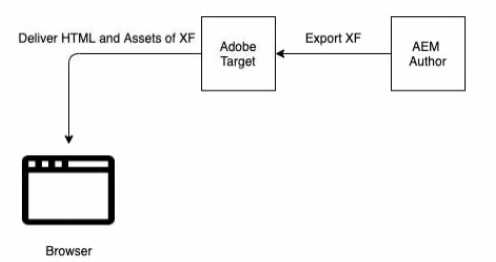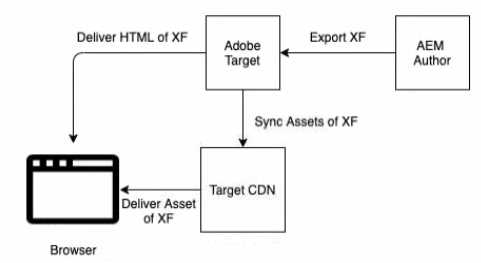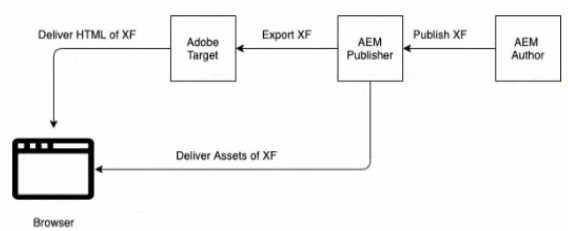Adobe ad0-e117 practice test
Adobe Experience Manager Sites Architect Master
Question 1
A news agency editor wants to publish news articles to an intermediate Publish (preview) instance
for internal review before publishing the article to production Publish instance.
Which two steps should the Architect recommend? (Choose two.)
- A. Create a closed user group (CUG) for editors
- B. Create a reverse replication agent on preview server
- C. Create a separate live copy to preview content
- D. Set up a new replication agent for preview server
- E. Create a custom publish workflow
Answer:
CD
Explanation:
Create a separate live copy to preview content and set up a new replication agent for preview
server1
. According to Adobe Experience Manager documentation
, a live copy is used to create a
local copy of content from another site that can be modified independently. A replication agent is
used to publish content from an author instance to a publish instance.
Creating a reverse replication
agent on preview server (B) is not necessary as reverse replication is not supported by AEM as a
Cloud Service1
.
Creating a custom publish workflow (E) is also not necessary as workflows are
handled by AEM Cloud Service automatically1
.
Question 2
A financial sector client is using AEM 6.5 on premise. The creative team needs to create the content
for the various marketing campaigns that are scheduled. The client wants to use Experience
Fragments (XF) to accelerate content creation for marketing purposes.
Which Data flow diagram should an Architect use to communicate requirements to the client
network team?
A)
B)
C)
D)
- A. Option A
- B. Option B
- C. Option C
- D. Option D
Answer:
B
Explanation:
A data flow diagram (DFD) is a graphical representation of the flow of data through a system. It
shows how data is input, processed, stored, and output in a system. A DFD can be used to
communicate requirements to the client network team by showing them how data flows between
different components and entities in the system.
Question 3
A user is part of the Employees LDAP group synchronized with AEM. The same user is added to the
authors group in AEM. The user is then removed from the Employees group on the LDAP server.
What is the result during the next synchronization with AEM?
- A. The user is removed from both the Employees and the AEM authors groups
- B. The user is removed from the authors group but not the Employees group in AEM
- C. The user is removed from the Employees group but not the authors group in AEM
- D. The user is not removed from either the Employees and the AEM authors groups
Answer:
A
Explanation:
“if a user is removed from an LDAP group that has been synchronized with AEM, then that user will
be removed from all AEM groups that they are a member of”.
Question 4
A client designs a new experience for one of their brand sites with the following parameters:
• The new experience should behave like a desktop application
• There is a lot of dynamic content in the app
• SEO and initial page load are a top concern for the client
• The client's marketing team needs to be able to author the content with a WYSIWYG editor
Which approach should the Architect use to meet these requirements?
- A. Use AEM as a headless CMS
- B. Use the traditional server side components on the website
- C. Use the SPA Editor SDK with Server Side Rendering
- D. Create a set of API-driven components
Answer:
C
Explanation:
“the SPA Editor SDK with Server Side Rendering allows for creating dynamic web applications that
behave like desktop applications while also supporting SEO and initial page load performance. It also
enables marketing teams to author content with a WYSIWYG editor”.
https://learning.adobe.com/content/dam/adls/certification/samples/en/AD0-
E104%20Adobe%20Experience%20Manager%20Architect_Exam_Guide_EN.pdf
Question 5
A client is in the discovery process for building a React native app, which is a single codebase that
runs natively on iOS and Android. The goal is to reduce development costs. The client wants to
reduce content creation costs in the new react Native app by reusing as much of the marketing
content already publish in their AEM instance.
What should the Architect recommend to meet this requirement?
- A. Experience Fragments
- B. OSGi Bundles
- C. Sling Resource Resolution
- D. Content Fragments
Answer:
A
Explanation:
“Experience Fragments are reusable pieces of content that can be delivered to any channel, including
React native apps. They allow for reusing marketing content already published in AEM”.
Question 6
A customer's photo gallery site uses query parameters to filter photo search results. The site
experiences high AEM Publish server load when users filter photos on the site. The customer would
like to identify the cause of this issue.
What should the Architect investigate first?
- A. ignoreUrlParams configuration in dispatcher.any
- B. Dispatcher load balancing configuration
- C. Cache-Control Headers in dispatcher.any
- D. Volume of assets being loaded at a time
Answer:
C
Explanation:
“Cache-Control Headers in dispatcher.any control how long the dispatcher caches responses from the
publish server. If these headers are not configured properly, the dispatcher may cache stale or
dynamic content, resulting in high server load and poor performance”.
Question 7
A media company surveys the end users of their AEM Sites website. The survey identifies that it is
difficult to locate content on the site due to lack of relevancy and slow performance when navigating
through the large volume of content.
To address both issues, the business team suggests integrating an innovative taxonomy product to
the company s AEM implementation. The product is new on
the market and the development team has no experience with the technology.
Which two steps should an Architect recommend to evaluate this new feature? (Choose two.)
- A. Develop the integration as proof of concept with sample content
- B. Test usability of the feature with selected business users
- C. Develop the integration and deploy it to 50% of the production AEM instances
- D. Develop the integration as proof of concept with full production content
- E. Test usability of the feature withselected end users
Answer:
AE
Explanation:
“developing a proof of concept with sample content allows for testing the feasibility and
performance of the integration without affecting production data. Testing usability with selected end
users allows for validating the relevancy and user satisfaction of the feature”.
Question 8
An Architect is performing infrastructure and capacity planning for Author servers for a customer
using AEM 6.5. Which two factors would lead the Architect to pick a multi-author instance
architecture setup? (Choose two.)
- A. Website Traffic handled by servers
- B. Fail safeness of the servers
- C. Number of Parallel Authors
- D. Cache Efficiency on the dispatcher
- E. Types of actions performed by Authors
Answer:
B, C
Explanation:
“a multi-author instance architecture setup provides failover and load balancing for author servers. It
also allows for scaling up the number of parallel authors who can work on the same content without
affecting performance”.
Question 9
A large digital agency has 10 TB of assets in their DAM where renditions for each Asset must be
created without affecting performance for the authors. Which capability should the Architect
recommend to meet the requirements?
- A. Reduce the number of AEM Asset versions
- B. Create AEM multi-threaded workflow
- C. Use AEM Asset Offloading
- D. Update dispatcher configuration to cache Assetsa
Answer:
C
Explanation:
“AEM Asset Offloading allows for delegating asset processing tasks such as rendition generation to a
separate AEM instance or service. This reduces the load on the author servers and improves
performance for authors”.
Question 10
A customer is about to go live with a new website on AEM on prem. The DNS (www.domam.com)
already points to the load balancer of the AEM environment and final sanity checks are being
performed. The website was tested in lower environments without SSL On production, the website is
served over https. During sanity testing, all requests result in a 404.
While investigating this issue, an Architect determines the following:
• The requests land on port 443 on the load balancer where SSL is terminated and an HTTP header
X-Forwarded-Proto is set
• The website Sling Mapping is created beneath /etc/map/http/www.domain.com.80
• The URLs on the website are externalized with http in the absolute links
Which two actions should the Architect take to resolve this problem? (Choose two.)
- A. Ensure the Sling Mapping exist at /etc/map/https/www.domain.com.80
- B. Ensure the Sling Mapping exist at /etc/map/httpj)mwp<.domain.com.443Configure the Adobe Granite SSL Connector Factory with the correct SSL port
- C. Configure Apache Felix Http Service SSL Filter to use the correct SSL forward header
- D. Ensure the Sling Mapping exist at /etc/map/https/www.domain.com.443
Answer:
B, C
Explanation:
“the Sling Mapping should match the protocol and port of the incoming request, which in this case is
https and 443. The Apache Felix Http Service SSL Filter should be configured to use the X-Forwarded-
Proto header to detect if the request is secure or not”.
Question 11
A customer has an international presence and a strong brand image. The customer considers the
exceptional quality images used for both print and on the website to be essential for its business, The
customer uses AEM 6.5 managed services with a configuration of 2 dispatchers, 2 publishers, and 1
author.
The original images can weigh up to 500Mb with videos weighing even more. Renditions are
generated after files are uploaded to AEM DAM by the Design team so the Authoring team can use
them on the website.
The teams report issues with platform stability and slowness. Visitors report that images look
pixelated on some screens and pages are very slow to load.
Which two actions should the Architect take to resolve these issues? (Choose two.)
- A. Train the design team to upload smaller assets and save the originals elsewhere
- B. Allocate more memory to ImageMagick and FFmpeg
- C. Optimize renditions for the different viewports used by the visitors
- D. Add more dispatchers and publishers to the AEM configuration
Answer:
C, D
Explanation:
“optimizing renditions for different viewports can improve the image quality and page load speed
for visitors. Splitting AEM Assets and Sites in two different stacks and using Connected Assets can
reduce the load on the author server and improve platform stability”.
Question 12
A client recently purchased the Smart Content Service and is considering using the Enhanced Smart
Tagging feature. As part of the process, the client recently created a new tagging taxonomy that has
not been applied to any assets yet. An Architect needs to demonstrate the feature on a subset of the
client's assets before using on all assets.
How should the Architect proceed?
- A. Add sample assets to a new folder, tag assets in folder, then enable Smart Tagging via the folder properties
- B. Add sample assets to a new folder, tag assets in folder, then run the Smart Tags Training workflow
- C. Enable Smart Tagging via the folder properties for a single folder of assets, then run the Smart Tags Training workflow
- D. Enable Smart Tagging via the folder properties for a single folder of assets
Answer:
C
Explanation:
“to use Enhanced Smart Tagging, the Architect needs to enable Smart Tagging via the folder
properties for a single folder of assets, then run the Smart Tags Training workflow to train the model
with the new tagging taxonomy”.
Question 13
An Architect needs to design a deployment process without downtime for end users. The system
architecture contains an AEM author, two AEM publishers, two publish Dispatchers, and a centrally
managed load balancer. The publishers serve some content that cannot be cached.
Which two actions should the Architect take to meet these requirements? (Choose two.)
- A. Connect each publish Dispatcher to one AEM publish
- B. Use each publish Dispatcher to load-balance to both AEM publishers
- C. Deploy software packages by replicating them from author to publishers
- D. Configure the centrally managed load balancer to connect directly to the AEM publisher that is not being dedKyed to
- E. Deploy software package to AEM Publishers one by one
Answer:
BE
Explanation:
“using each publish Dispatcher to load-balance to both AEM publishers can provide high availability
and fault tolerance. Deploying software packages to AEM Publishers one by one can avoid downtime
for end users”.
Question 14
An enterprise client is on-boarding an AEM Desktop application to provide authors with the ability to
load the AEM repository virtually on the file system. The desktop application is unable to connect to
the AEM Author, which has SSL enabled. The intermediate certificate is installed on Apache.
How should an Architect resolve this issue?
- A. Install the certificate chain to the keystore of the AEM authentication service user
- B. Install the Root certificate to the AEM truststore
- C. Install the certificate chain to the keystore of the AEM ssl-service user
- D. Install the certificate chain to the AEM truststore
Answer:
B
Explanation:
“installing the Root certificate to the AEM truststore can allow AEM Desktop application to connect
to AEM Author with SSL enabled”.
Question 15
A large AEM enterprise site is implementing authentication and requires a true optimal load
balancing across the site's multi AEM publish instances. Which approach should an Architect take to
meet this requirement?
- A. Configure Sticky Connections
- B. Configure the Dispatcher to run with a Dedicated System Usei
- C. Enable Encapsulated Token Option
- D. Enable Round Robin processing in Dispatcher configuration
Answer:
C
Explanation:
“enabling Encapsulated Token Option can provide optimal load balancing across multiple AEM
publish instances by using a token-based authentication mechanism”.